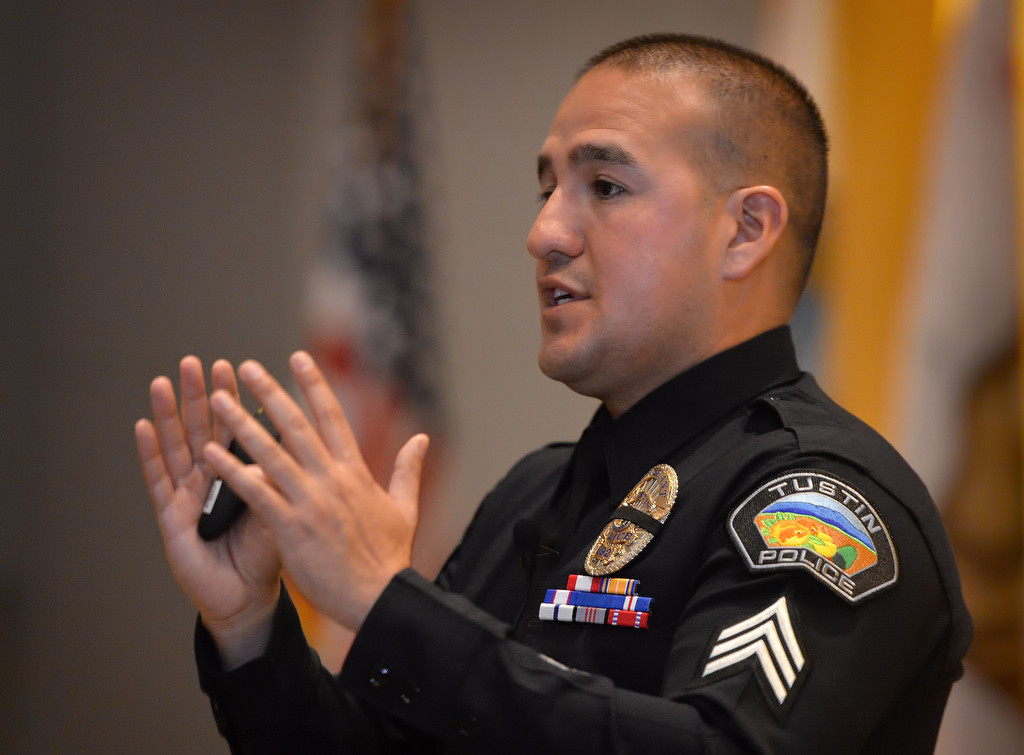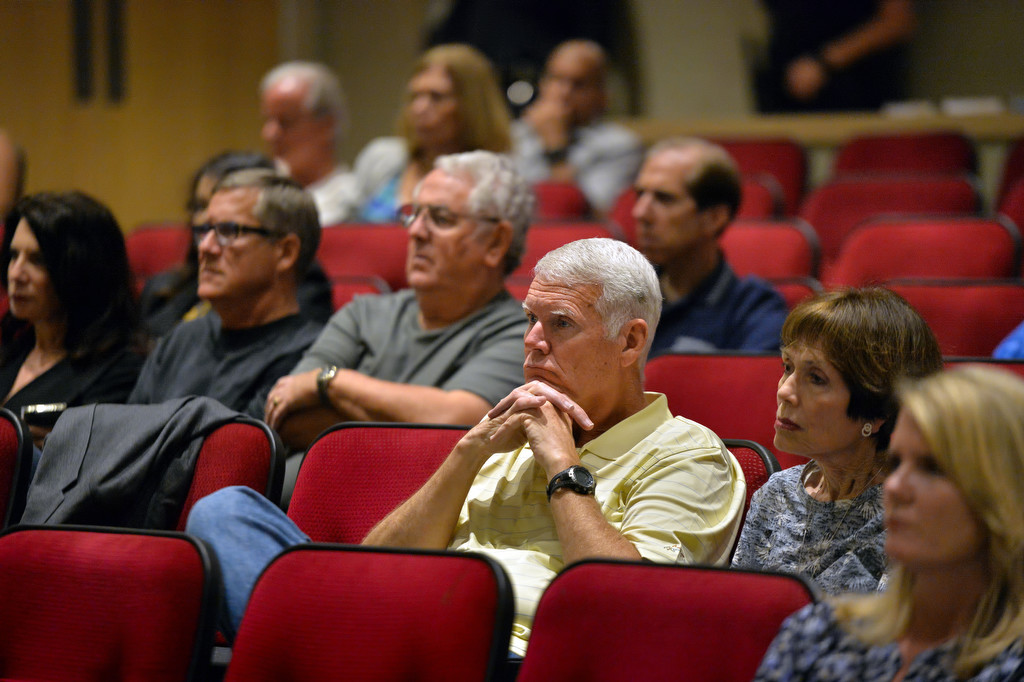Less than a second.
That is often the amount of time an officer has to make a decision in a potentially life-threatening situation.
Training, experience, perception and physics all play a role in how an officer will handle those situations.
Tustin police on a recent Wednesday held a town hall meeting that drew about 50 people to explain how and why police use force.

Tustin Police Chief Charles Celano talks to the public during a Use of Force Town Hall Meeting at the new Tustin Community Center.
Photo by Steven Georges/Behind the Badge OC
Tustin Police Chief Charles Celano said there is a growing divide between the public’s perception of law enforcement and the realities officers face every day.
“Part of why we’re here tonight is to bridge that gap,” Celano told the audience. “If we truly want to be effective, we have to partner with all of you.”
So far this year, Tustin has seen violent crime at a record low since 1978, but daily police are responding to, and handling, various types of calls.
Most interactions with the public or suspects don’t require use of force.
Last year Tustin PD fielded 31,600 calls for service, which yielded 4,232 arrests. In 16 of those incidents, an officer used some type of force requiring administrative review.
An administrative review is mandatory in all instances where the use of a Taser, baton/ASP, pepper spray, kinetic energy munitions, carotid restraint, or other less-lethal methods. Any other use of force that results in death or serious injury, loss of consciousness, or an incident in which the supervisor feels it is necessary, also requires an administrative review.
Every use-of-force incident is reviewed by the police department to ensure the officers acted appropriately, Celano said.
Nationwide, the number of use-of-force incidents mirrors Tustin’s statistics — they are a fraction of the arrests made every day. The most shocking of these are often splashed across headlines or blasted out on social media.
“The incidents that are on every front page are not the norm,” Celano said. “While any death or injury at the hands of law enforcement is tragic and regrettable, these incidents are very rare.”
Less rare, Celano said, are the incidents in which officers are injured or killed in the line of duty.
“We must remember that the threats faced by our police officers are very real,” Celano said. “Nationwide, there were more than 50,000 assaults on officers, more than 14,000 officers injured and there were 126 officers killed in 2014.”

Sgt. Manny Arzate talks about Use of Force during a Tustin PD Town Hall Meeting at the new Tustin Community Center.
Photo by Steven Georges/Behind the Badge OC
Why officers use force
Much goes into an officer’s decision to use force including a suspect’s age, body build, height and whether a person is intoxicated.
“There’s a higher level of pain tolerance when you’re dealing with someone who is intoxicated,” said Sgt. Manny Arzate.
Mental illness introduces another factor into many encounters with police that can change the way an officer approaches a scenario.
But no matter what the situation, officers are always faced with some element of the unknown, he said.
“In our occupation, we are reactive,” Arzate said. “When we do a traffic stop in the middle of the night, or respond to that bank robbery or to a person who committed a crime, (that suspect) already knows what has occurred. We don’t.”
This uncertainty puts officers on high alert, ready to apply their training and experience.
“(Using force) is not something we look forward to,” Celano said. “We do use less-lethal and it is effective, but you’re not going to hear about it. You’re not going to see it on the news; you’re not going to see it on Facebook.”
The science behind force
Use of force can include using less-lethal methods, such as a firm grip or a Taser, or a lethal method: firing a weapon.
When it comes to lethal force, there are two things officers never do: They don’t shoot to wound, and they don’t shoot to kill.
“We shoot to stop the threat,” said Sgt. Sean Quinn.
Using a volunteer from the audience and a “blue gun,” which is a training gun, Quinn demonstrated to the audience the science behind how quickly a scenario can turn life-threatening for an officer.
A person with a weapon — any kind of weapon, including a knife or a hammer — can cause harm if within 21 feet of an officer, Quinn said.
At that distance, a suspect can be within striking distance in just over a second. It takes nearly two seconds for an officer to draw and fire a weapon.
“It’s all time, speed and perception; it’s physics,” Quinn said. “We are behind the curve on every single encounter we come across.”
Some in the audience said they were shocked by the little time officers have to react in these high-adrenaline situations.
“It is just milliseconds they have to make a decision,” said Sandra Tashan, who attended the event with her husband. “It was eye-opening.”
 Behind the Badge
Behind the Badge




